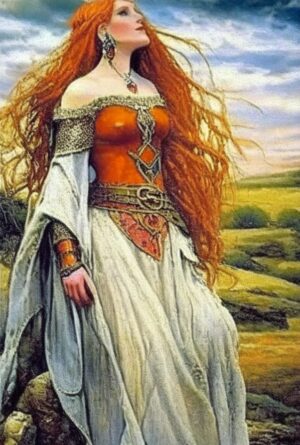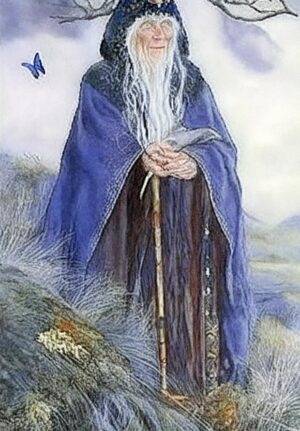Today we’re sharing the 8 most famous Celtic witches of all time, including infamous Irish witches and Scottish witches as well as some deities.
Got a soft spot for the enchanting tales from the Celtic corners of the world? You’re in the right place! We’re about to journey through the misty hills and ancient forests to uncover stories of the most iconic and famous Celtic witches. These women weren’t just legends; they were powerful figures who shaped history with their wisdom, spells, and sometimes, a bit of mischief.
Let’s dive deeper into the tales behind these famous Celtic witches and find out what makes them so legendary.
What Is Celtic Witchcraft?
Celtic witchcraft is like an old, intricate tapestry that goes back thousands of years. It comes from the Celtic tribes who lived in places like Ireland, Scotland, and Wales. This kind of Celtic witchcraft is super connected to nature and the mysteries of life.
1. Who Were the Druids? Druids were the big shots in the Celtic spiritual world. Think of them as the wise folk who talked to gods, held ceremonies in cool forest groves, and knew a ton about magic.
2. The Celtic Gods and Goddesses: The Celts had loads of gods and goddesses they respected. Some of the big names include Brigid, who was all about healing; Cernunnos, the dude with horns; and Morrigan, a powerful goddess linked with war.
3. Party Times: The Big Festivals: The Celts loved their seasonal festivals. They had four main ones: Imbolc, Beltane, Lughnasadh, and Samhain. Samhain’s the one you might recognize—it’s a bit like today’s Halloween, where they believed the spirit world got super close to ours.
4. Nature’s Magic: For Celts, nature wasn’t just trees and rivers. These places were filled with magic! They had special sites, like Stonehenge, and believed that many natural spots were homes for spirits.
5. Mixing Things Up: When the Romans came, and later, when Christianity spread, things changed a bit. The old gods got new names, and some old practices got a makeover to fit the new beliefs. But the Celts were clever; they kept many of their traditions alive in sneaky ways. Many of the modern-day Irish Catholic saints are actually variations of Celtic witchcraft deities.
6. The Comeback: Nowadays, people are super into Celtic witchcraft again. Lots of folks are digging into the past to bring back and adapt the old ways. It’s all about reconnecting with ancient traditions and nature’s magic.
So, there you have it! Celtic witchcraft is all about nature, cool ceremonies, and some powerful gods and goddesses. Even with all the changes over the years, its magic still sparks interest today.
Next, let’s dive into some of the most famous Celtic witches in history. Many of these famous Celtic witches are just super cool, but they can also be useful to work with in a patron deity sense.
Famous Celtic Witches
Here are some of the most famous Irish witches and Scottish witches throughout history.
8. Boudicca (Boadicea)

Boudicca, also known as Boadicea, was the queen of the Iceni tribe, a Celtic tribe in ancient Britain. While she might not be your typical ‘witch’, she was deeply spiritual, and her story is intertwined with druidic traditions and magic. When the Roman Empire tried to annex her territory and mistreated her family, she led a massive revolt in AD 60 or 61. With her fiery red hair, she rode her chariot into battle, evoking fear in the hearts of the Romans. Many believed she had the power of the old gods behind her. Her passion, strength, and connection to the spiritual realm make her an icon in the world of Celtic witchcraft.
Boudicca’s legend speaks of her determination and courage. Although her revolt was eventually suppressed, her spirit lived on. She became a symbol of resistance and empowerment, inspiring many in the witchcraft community. Her energy is often invoked for strength, protection, and justice, making her an enduring figure in the world of magic.
7. The Cailleach

The Cailleach is one of the most ancient and powerful figures in Celtic witch mythology. Often depicted as an old crone, she represents winter, darkness, and the death aspect of the triple goddess. The Cailleach controls the cold months, using her magical staff to freeze the ground and call forth storms. She’s not just a bringer of cold, though; she’s a shape-shifter, a creator of landscapes, and a wise old woman who knows the mysteries of the universe.
Her stories are scattered across Ireland, Scotland, and the Isle of Man. In some tales, she’s said to have crafted the mountains and hills, shaping the very earth with her hands. In others, she keeps a cauldron of life, controlling the cycles of birth, death, and rebirth. For modern Irish witches, the Cailleach is a symbol of the transformative power of darkness and the wisdom that comes with age. By working with her energies, practitioners can delve deep into the mysteries of the shadow self and the natural world.
6. Airmid

A lesser-known but equally vital figure in the Celtic pantheon is Airmid, a goddess associated with healing, herbalism, and the magic of plants. As one of the Tuatha Dé Danann, the mythical race of gods in Irish folklore, Airmid’s story is deeply connected to the art of healing. When her brother Miach was killed, it is said that 365 herbs grew from his grave, each corresponding to a part of the body. Airmid gathered these herbs and arranged them, intending to use their power to bring her brother back to life.
However, her father Dian Cecht, possibly jealous of her knowledge, scattered the herbs, making their secrets hard to decipher. Airmid’s tale is a poignant reminder of the preciousness of herbal knowledge and the sacrifices made to acquire it. Today’s witches often honor Airmid when working with herbs, invoking her wisdom and expertise in their craft. Her story serves as a bridge between the ancient world of the Celts and the modern practices of herbalism and green witchcraft.
5. Morrigan

The Morrigan, often simply called Morrigan, is a complex and multifaceted goddess in Celtic mythology. She’s best known as the goddess of war, fate, and death but also encompasses aspects of fertility and sovereignty. Often depicted as a trio of sisters or aspects – Anand, Badb, and Macha – she’s frequently associated with the crow or raven, creatures that fly between the realms of life and death.
Her presence in the battlefield is both fearsome and awe-inspiring. Legends tell of her flying overhead in the form of a crow, predicting the death of warriors and sometimes influencing the outcome of wars. However, beyond her warrior aspect, Morrigan also has deep ties to the land and its rulership. Her connection to the cycles of life and death, as well as her transformative nature, makes her a compelling figure for many witches today. By embracing the Morrigan’s energy, modern practitioners can harness the power of transformation, rebirth, and understanding the deeper mysteries of existence.
4. Biddy Early, The Wise Woman of Clare

Biddy Early is another captivating figure in the tapestry of Celtic witchcraft and folklore. Born in the early 19th century in County Clare, Ireland, Biddy became renowned as a healer, herbalist, and wise woman. Unlike the infamous Alice Kyteler, Biddy’s legend is steeped more in her role as a community healer than any dark controversies.
Throughout her life, Biddy was known to use a mysterious “blue bottle” which she would gaze into, much like a crystal ball, to gain insights or diagnoses for the ailing individuals who sought her out. The origins and true nature of this bottle have been a subject of speculation and lore. Some say it was given to her by the fairies or the spirits of the Otherworld, while others believe it was a gift from a mysterious man she loved.
While Biddy was certainly sought after for her abilities, she wasn’t without her detractors. The Catholic Church was not a fan of her practices. Biddy was often at odds with them, primarily because people in her community would sometimes prioritize her treatments over the Church’s sacraments.
Her home became a beacon for those in need, drawing in individuals from all over who were looking for cures for their ailments or solutions to their problems. Tales of her healing the sick, assisting in matters of love, and communicating with the spirit realm have solidified her status as one of Ireland’s most legendary wise women.
What stands out most about Biddy Early is her resilience and commitment to her community. In a time and place where many women like her faced persecution, Biddy managed to carve out a space for herself, serving as a healer and confidante to those who believed in her gifts.
3. Brigid (Bridget)

Brigid, or Bridget, is another key figure in Celtic mythology and spirituality. She stands in stark contrast to figures like the Morrigan. Brigid is the goddess of fire, poetry, healing, and smithcraft. Often celebrated during the festival of Imbolc, which marks the beginning of spring, she represents the promise of renewal, light, and warmth.
Temples dedicated to Brigid, like the one at Kildare, maintained an eternal flame in her honor, signifying her undying light. As the patroness of poets and bards, Brigid’s influence is felt in the lyrical and musical traditions of the Celts. For modern witches, Brigid is often invoked for creativity, healing rituals, and any magic related to inspiration. Her energy is nurturing, protective, and enlightening, making her a favorite among those who walk a path of light and healing.
2. Alice Kyteler

Alice Kyteler is a fascinating figure in the annals of witchcraft history, especially when discussing famous Celtic witches and the progression of witch trials in Europe. Born in Kilkenny, Ireland, in the 1280s, Alice was an affluent woman who was married four times. Her repeated instances of widowhood raised suspicions, and by her fourth husband’s death, rumors began to swirl around Kilkenny about her involvement in Celtic witchcraft.
In 1324, she was formally accused of practicing maleficium – harmful magic. The charges against her were grave, including heresy, money lending, and using sorcery to kill her husbands. The most sensational allegations included her hosting secret nocturnal meetings at her inn where she and her associates supposedly denied the faith, sacrificed animals, and consorted with a demon.
Bishop Richard de Ledrede took a particular interest in her case, and her trial became one of the earliest, well-documented witch trials in Europe. What made the Kyteler case even more remarkable was the socio-political intricacies involved. Alice, being wealthy and well-connected, managed to avoid the worst outcomes of the trial.
While Alice’s maid, Petronilla de Meath, unfortunately, became the first recorded person to be burned at the stake for witchcraft in Ireland, Alice herself evaded capture. She fled, and her subsequent whereabouts remain a mystery.
Alice is one of the most infamous Irish witches and many psychics today have connected with energy, implying that she actually did practice witchcraft, or at the very least, energy magic.
1. Rhiannon

Originating from Welsh mythology, Rhiannon is a potent figure associated with horses, birds, and the Otherworld. First introduced in the Mabinogi, a collection of medieval Welsh tales, she rides a mystical horse and possesses a set of magical birds whose songs can enchant the living and awaken the dead. Rhiannon’s tales are those of love, loss, and perseverance.
Despite facing numerous trials, including being falsely accused of harming her son and subsequently being punished, Rhiannon’s grace, dignity, and strength never wavered. Her story is one of resilience, and she is often sought after by witches and spiritual seekers who are undergoing challenges or seeking to connect with the mysteries of the Otherworld. By aligning with Rhiannon’s energy, one can find strength in adversity and unlock the deeper magic that exists just beyond our realm.
It’s clear that the tales of Irish witches, Scottish witches, and the broader realm of Celtic witchcraft are more than just stories from the past. These narratives, steeped in mysticism and ancient practices, offer a mesmerizing glimpse into the powerful figures who shaped the spiritual landscape of the Celtic world. From the misty highlands of Scotland to the rolling green hills of Ireland, the legends of these witches remind us of the deep-rooted traditions and the indomitable spirit of Celtic witchcraft.
As we’ve explored, whether it’s the wisdom of Irish witches, the enchantments of Scottish witches, or the rituals of Celtic witchcraft, there’s a timeless allure that beckons to those seeking connection with the old ways. So, here’s to the magic of the past and the enduring legacy of Irish witches, Scottish witches, and the rich tapestry of Celtic witchcraft!
Want to learn more? I recommend checking out The Book of Celtic Magic, which is a great doorway into the wonderful world of Celtic witchcraft.


